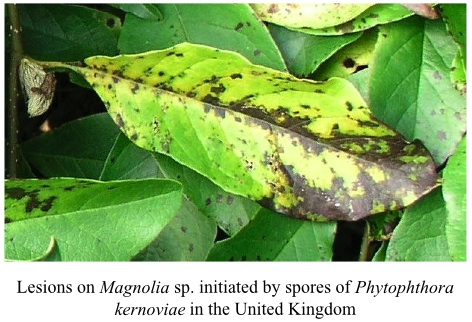PESTS AND DISEASES OF FORESTRY IN NEW ZEALAND
Phytophthora kernoviae in New Zealand
Scion is the leading provider of forest-related knowledge in New Zealand
Formerly known as the Forest Research Institute, Scion has been a leader in research relating to forest health for over 50 years. The Rotorua-based Crown Research Institute continues to provide science that will protect all forests from damage caused by insect pests, pathogens and weeds. The information presented below arises from these research activities.
From Forest Health News 161, April 2006.
 Ensis scientists Tod Ramsfield and Margaret Dick are currently collaborating with Ross Beever of Landcare Research and Ian Horner of HortResearch on a Ministry of Forestry (MAF) funded project that is studying the genus Phytophthora in New Zealand. The purpose of the project, which is led by Landcare Research, is to verify which species of Phytophthora are present in New Zealand, using both molecular and morphological techniques. The genus Phytophthora contains many serious plant pathogens, such as P. infestans, the causal agent of late blight of potato that was responsible for the Irish potato famine, and P. ramorum, the causal agent of the disease known as sudden oak death (See The California Oak Mortality Task Force (COMTF)). The project is utilising cultures from the Landcare International Collection of Micro-organisms from Plants (ICMP), from the New Zealand Forest Research Culture Collection (NZFS), and from collections held by HortResearch and MAF. DNA sequence data that is lodged in the international database ‘GenBank’ has been used as the primary reference for molecular information.
Ensis scientists Tod Ramsfield and Margaret Dick are currently collaborating with Ross Beever of Landcare Research and Ian Horner of HortResearch on a Ministry of Forestry (MAF) funded project that is studying the genus Phytophthora in New Zealand. The purpose of the project, which is led by Landcare Research, is to verify which species of Phytophthora are present in New Zealand, using both molecular and morphological techniques. The genus Phytophthora contains many serious plant pathogens, such as P. infestans, the causal agent of late blight of potato that was responsible for the Irish potato famine, and P. ramorum, the causal agent of the disease known as sudden oak death (See The California Oak Mortality Task Force (COMTF)). The project is utilising cultures from the Landcare International Collection of Micro-organisms from Plants (ICMP), from the New Zealand Forest Research Culture Collection (NZFS), and from collections held by HortResearch and MAF. DNA sequence data that is lodged in the international database ‘GenBank’ has been used as the primary reference for molecular information.
During analysis, it was noted that DNA sequence data from one culture named ‘ Phytophthora hibernalis’ that had been isolated from custard apple (Annona cherimola) in Northland in 2002 did not cluster with authentic P. hibernalis sequences. In fact, the data suggested that the best match for the culture in question was the newly described (2005) species Phytophthora kernoviae. The morphological characteristics of the culture matched the published description of P. kernoviae and scientists from overseas have confirmed the identification. A further isolate of the pathogen was subsequently located in the ICMP. This second isolate had been recovered from the soil in Trounson Kauri Park in 2003.
Phytophthora kernoviae is a serious pathogen of Fagus sylvatica, Quercus robur, Q. ilex, and Liriodendron tulipifera in Cornwall, England. It causes large cankers on the stem which kill the trees if the stem is girdled. The inoculum that infects the trees builds up on the leaves of understorey plants, such as a number of species of Rhododendron, Magnolia, and Pieris. As New Zealand Nothofagus is closely related to Fagus, there is concern over the potential effects of this fungus on beech in New Zealand.
Biosecurity New Zealand (BNZ) was immediately notified of the identification by Landcare Research and has since begun an incursion investigation and has established a technical advisory group to provide expert advice for incursion management. Biosecurity New Zealand is currently working under the assumption that P. kernoviae is an exotic pathogen that has recently arrived in New Zealand. As the mode of action of P. kernoviae is similar to that of P. ramorum, there was a strong response from some international trading partners following the notification issued by BNZ.
The potential impact of P. kernoviae in New Zealand remains uncertain. The pathogen has so far been recorded at just two sites and we can verify that it has been in New Zealand for a minimum of 4 years. To date, disease has been observed on only one host, A. cherimola an exotic sub-tropical fruit. Clearly, further study of this organism, including its host range and geographic distribution in New Zealand, is necessary and it is hoped that these studies will begin in earnest soon.
For more information on Phytophthora kernoviae in the UK see the UK Forestry Commission.
Margaret Dick and Tod Ramsfield
This information is intended for general interest only. It is not intended to be a substitute for specific specialist advice on any matter and should not be relied on for that purpose. Scion will not be liable for any direct, indirect, incidental, special, consequential or exemplary damages, loss of profits, or any other intangible losses that result from using the information provided on this site.
(Scion is the trading name of the New Zealand Forest Research Institute Limited.)

 Farm Forestry New Zealand
Farm Forestry New Zealand

